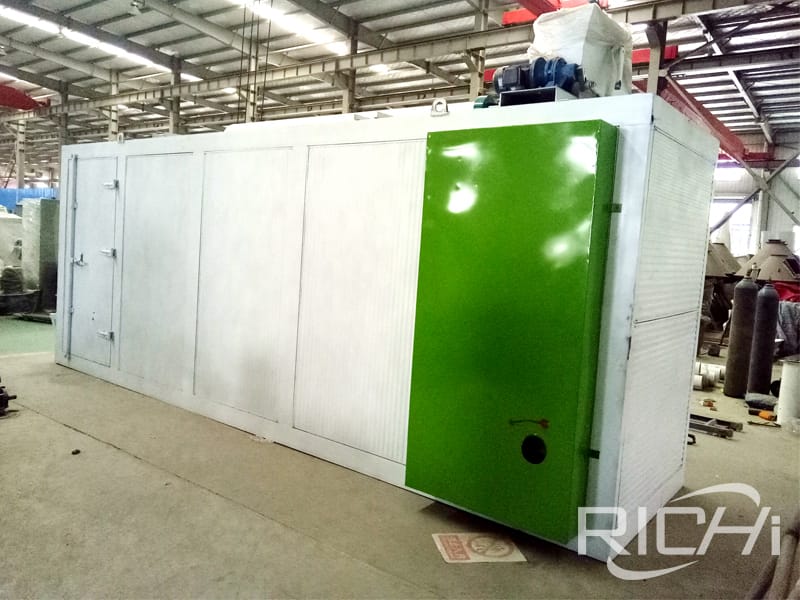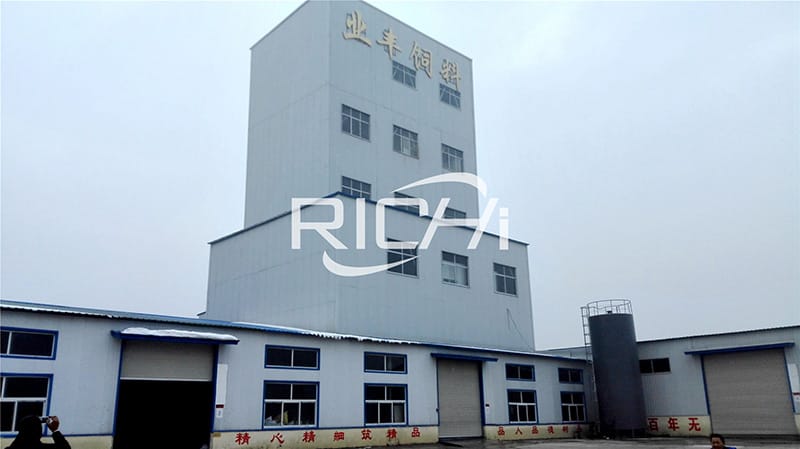Feed drying equipment for large scale animal feed processing plant made in China
In recent years, the development of the feed industry has shown a new trend, and the extrusion technology has gradually been accepted by many large scale animal fish feed mill plants due to its unique advantages. After fish pet feed extruder equipment entered the feed processing industry, it soon became one of the main models for producing high-end extruded aquatic feed.
Under normal circumstances, the water content of extruded products is relatively high. Taking floating fish feed as an example, after extrusion, the water content is usually 21%-24%, while the safe storage water content of extruded aquatic feed is generally required to be controlled at 10% or so, ordinary cooling equipment alone can no longer meet the need for water removal, which requires the establishment of special feed drying treatment sections in the animal feed line production process and the addition of special feed drying equipment.

At present, the feed drying equipment used in the feed industry is mainly divided into vertical dryers and horizontal dryers (also known as "horizontal feed dryers"). Vertical dryers are rare now, and most of the large and medium-sized aquatic feed plants newly built in recent years use horizontal feed dryers.
Most horizontal dryers have built-in single-layer or multi-layer conveyor belts (or steel plate tracks with holes) to support the movement of materials in the drying room. The hot air passes through the material layer vertically, exchanges heat and moisture with the material on the conveyor belt, and is then discharged through a special channel. This is the general working principle of horizontal feed drying machines. Because the material moves along the conveyor belt in the drying room, its movement speed is slower, the path is longer, and the drying time is also longer than that of a vertical dryer. All materials have roughly the same external drying conditions, so the horizontal dryer is better than the vertical dryer in terms of the precipitation range or the moisture uniformity of the finished product. This is determined by the drying principle and mechanical structure of the horizontal feed dryer.
Drying treatment is a relatively complex process and is restricted by many factors, such as drying time, hot air temperature, hot air volume, physical properties and geometric shapes of material components, etc., will affect the final drying effect, which is specifically reflected in the product, that is, the product moisture and Two main indicators of moisture unevenness. An excellent and stable drying treatment system not only refers to a powerful feed dryer, but also includes parts such as auxiliary mechanical devices, thermal energy systems, air duct systems, and electrical control systems. A good drying effect is the result of the combined effects of all components in the feed drying system. The following aspects should also be considered in the selection and operation process:
1. A spreader
For horizontal feed dryers, the quality of the spreader directly affects the uniformity of product moisture, which is a relatively important link in the drying system.
The spreader spreads the material evenly on the conveyor belt, so that the air flow at each point on the conveyor belt is roughly the same, which is one of the prerequisites for uniform product moisture. The spreader can be subordinate to the feed dryer, or can form a separate device independently, with many forms, such as oscillating, horizontal rake, oscillating conveyor belt and so on. Users can choose a suitable form according to actual needs. Not damaging the appearance of the material is another principle besides the spreading effect.
At present, the more mature one is the oscillating spreader, which has simple mechanical structure, reliable transmission, adjustable oscillation frequency and amplitude, and good spreading effect, which is suitable for most aquatic extruded feeds.
2. System and wind path
Consider providing sufficient and stable heat for the feed dryer, otherwise the stability of the dryer cannot be guaranteed. The feed dryer can choose steam, heat transfer oil or gas as the heat source, and the gas efficiency is higher.
Because some aspects of the animal feed processing technology require the intervention of steam, such as pelleting, puffing, etc., in general, steam should be the first choice for the heat source of the feed dryer, which can reduce the initial investment of the plant and save daily management costs.
The heat exchanger is the core component of the heating system. From the practical application effect, the performance of the steam heat exchanger of the steel-aluminum composite fin tube is better, and the fin tube is not easy to deform and accumulate water.
The traditional horizontal feed dryer uses a larger heat exchanger to send hot air into each drying chamber through multiple branch air paths. The problem with this approach is that the distribution of air volume in each drying chamber is not easy to control, the branch air paths need to be insulated, and it occupies a large space outside the dryer, and the structure is more complicated. Richi Machinery HRHG series multi-pass convection belt dryer uses independent heating and built-in air ducts in each drying room to solve the above problems. At the same time, the hot air recycling greatly reduces the energy consumption of the dryer. The hourly processing capacity is 3.5 tons (φ3mm extruded floating fish feed), and the steam consumption is about 1.5t/h when the moisture is reduced from 24% to 10%.

3. Control System
The automatic control of the feed drying system is more difficult to achieve, because there are many factors that affect the drying process, and there are many links that need to be controlled. The entire control system is expensive, which is uneconomical for feed drying. Then a more realistic method should be to automatically adjust a certain important parameter and manually adjust other parameters. The drying temperature of the feed dryer is automatically adjusted, while the air volume and drying time are manually adjusted. The automatic temperature control ensures that the dryer can still work in a relatively stable temperature range when the steam fluctuates.
4. Materials processed
The composition and physical properties of the material also have a great influence on the final drying effect:
① If the feed formula contains a high proportion of fats, it is unfavorable to dry.
②When the feed pellets are relatively dense, it is not conducive to the diffusion of water inside the pellets to the surface of the pellets along the capillary.
③When the feed particle size is large, longer drying time is required.
④The size of all feed particles should not be too different, otherwise it is difficult to obtain a good drying unevenness index.
⑤ Under normal circumstances, sinking fish feed is more difficult to dry than floating fish feed.
5. Some suggestions
①Drying requires heat. Within the allowable limit, a higher temperature will help improve the efficiency of the animal feed dryer machine. However, high temperature conditions will affect the nutritional value of feed, such as non-enzymatic browning. Usually the feed drying temperature should not exceed 120℃. You can also consider allowing the feed to stay in a high temperature (100°C to 200°C) environment for a few minutes to quickly heat up the pellets, and then lower the hot air temperature to complete the remaining drying operations.
②It is necessary to avoid the rapid loss of water on the surface of the particles during the initial stage of drying, forming a "water seal", destroying the capillary connecting the surface and the inside of the particles, and preventing the core moisture from eventually spreading out.
③The drying process of any material requires a certain amount of time. During large feed line drying process, operating parameters should not be changed frequently, and a certain reaction time should be left for the dryer. Only in this way can the best operating parameters of a certain material be obtained.
If you want to built one complete pellet production line in your country, pls send the inquiry to us. We will customized design according to your requirement.



